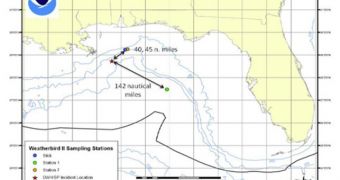Between May 22-28, the University of South Florida (USF) dispatched its R/V Weatherbird II to the Gulf of Mexico, in order to follow up on the devastation produced by the explosion and sinking of the Deepwater Horizon oil rig. The investigators there collected samples from three locations across the Gulf, including 40 and 42 nautical miles to the northeast of the well head and 142 nautical miles southeast of the well head. Yesterday, the US National Oceanic and Atmospheric Administration (NOAA) announced the results of an independent analysis it carried out on the same samples.
According to the new data, very low concentrations of sub-surface oil and PAH (polycyclic aromatic hydrocarbons) exist at the three study sites, at depths ranging from 50 to 1,400 meters. This means that the underwater plume is fairly massive, but relatively devoid of oil. However, even the minute concentrations that can be found in the water can have devastating effects on fish and ecosystems. The information NOAA obtained also shows that PAH level can be measured in parts per trillion, which is very little. This is nothing but good news for these particular locations.
“We have always known there is oil under the surface; the questions we are exploring are where is it, in what concentrations, where is it going, and what are the consequences for the health of the marine environment? This research from the University of South Florida contributes to this larger, three-dimensional puzzle we are trying to solve, in partnership with academic and NOAA scientists,” explains Dr Jane Lubchenco, who is the current NOAA Administrator.
“NOAA’s analysis of the Weatherbird II samples shows that concentrations of hydrocarbons decrease with depth, with a notable exception of samples at 300 meters from Station 07, which warrants additional research attention. Also, PAH levels are very low in all samples, with only five of 25 having reportable concentrations of the priority pollutant PAH,” explains the chief scientist for NOAA Fisheries, Dr Steven Murawski. Tracking these chemicals will become easier with the recent deployment of the NOAA P-3 “Hurricane Hunter” vessel, which is deploying instruments to assist this effort.
“We are deeply concerned about what this oil spill means for the health of the Gulf of Mexico, and for the millions of people who depend on these waters for their livelihoods and enjoyment. NOAA is using all the scientific methods at our disposal to assess the damage, from satellites in space, planes in the air, boats on the water, gliders under the sea, scientists in the field, and information online,” Lubchenco concludes.

 14 DAY TRIAL //
14 DAY TRIAL //